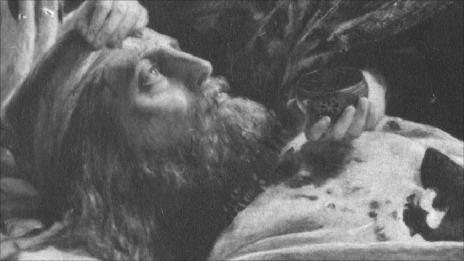Ex-Bangor University professor reveals 'true Camelot'
- Published

Previous best guesses for the home of Camelot include Winchester, Monmouthshire, and Somerset
The quest to find King Arthur's Camelot has puzzled and intrigued scholars and fans for over a thousand years.
The mythical ruler's legendary court has been associated with locations throughout Wales, including Carmarthen, St David's, and Cardigan.
Now a retired Bangor University professor has revealed what he believes to be the true location of Camelot.
And it turns out to be a small Roman fort at Slack, on the outskirts of Huddersfield in West Yorkshire.
Prof Peter Field, a renowned expert in Arthurian literature, said: "It was quite by chance. I was looking at some maps, and suddenly all the ducks lined up.
"I believe I may have solved a 1,400-year-old mystery."
Previous best guesses for the location of the round table include Caerleon in Newport, Somerset's Cadbury Castle, and Tintagel in Cornwall.

Slack, west Yorkshire - the true Camelot?
In Roman times, Slack was home to a fort called Camulodunum, which means "the fort of the god Camul".
Over the years, well-recognised linguistic processes would have reduced Camulodunum to Camelot.
Though almost forgotten and insignificant today, and even though it was abandoned and dilapidated by the relevant time of King Arthur around A.D. 500, Prof Field argues that this site at Slack would still have been considered a strategic stronghold.
At that time, Celtic-speaking Britons, who could have been led by King Arthur, held the north and the west coast against the invading Anglo-Saxons.
Slack, on the Roman road from Chester to York, would have been the ideal location from which to defend the east coast.

The wizard Merlin - or Myrddin - has long been associated with Carmarthen
Prof Field added: "If there was a real King Arthur, he will have lived around AD500, although the first mention of him in Camelot is in a French poem from the Champagne region of France from 1180.
"There is no mention of Camelot in the period between those dates, known as the Dark Ages, when the country was at war, and very little was recorded.
"In this gap, people passed on information, much got lost in transmission, and people may have made up facts or just messed up known information."
Prof Field, who taught at Bangor from 1964 to 2004, has been researching the location of Camelot for the past 18 months.
He spoke about his findings during the official launch of Bangor University's Stephen Colclough centre for the history and culture of the book.
- Published9 June 2011
